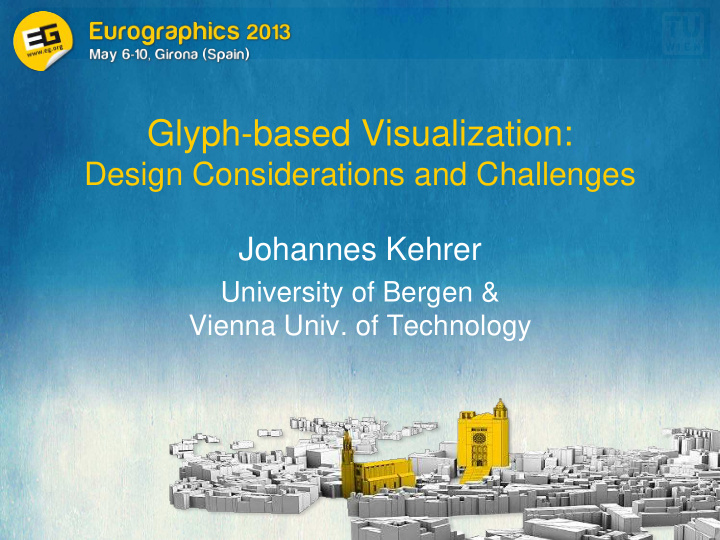



Glyph-based Visualization: Design Considerations and Challenges Johannes Kehrer University of Bergen & Vienna Univ. of Technology
How to design a successful Glyph? Some visual channels are more dominant [Ware 04] Some can be compared more accurately angle position length saturation volume area slope [Cleveland&McGill 84] 2 Johannes Kehrer
Challenges in Glyph Design integral pairs red-green yellow-blue width height size orientation color shape color motion color location separable pairs [Ware 04] 3
Design Considerations [Ward 02/08, Ware 04, Ropinski et al. 08/11, Lie et al. 09, Maguire et al. 12] 4 Johannes Kehrer
Visualization Space 3D Surface glyphs 2D Star glyphs Stick figures Chernoff Profile glyphs [Kindlmann&Westin 06] [Meyer-Spradow et al. 08] faces 5 Johannes Kehrer
Complexity vs. Density dense & simple sparse & complex Stick figures Glyph packing Helix glyphs Local flow probe [Pickett&Grinstein 88] [Kindlmann&Westin 06] [Tominski et al. 05] [de Leeuw&van Wijk 93] 6 Johannes Kehrer
Complexity vs. Density dense & simple sparse & complex Stick figures Glyph packing Helix glyphs Local flow probe [Pickett&Grinstein 88] [Kindlmann&Westin 06] [Tominski et al. 05] [de Leeuw&van Wijk 93] attributes mapped to angles texture patterns Stick figures [Pickett&Grinstein 88] 7 Johannes Kehrer
Complexity vs. Density dense & simple sparse & complex represent multiple flow properties sparsely placed Stick figures Glyph packing Helix glyphs Local flow probe [Pickett&Grinstein 88] [Kindlmann&Westin 06] [Tominski et al. 05] [de Leeuw&van Wijk 93] Local flow probe [de Leeuw&van Wijk 93] 8 Johannes Kehrer
Hybrid Visualizations Layering [Kirby et al. 99] Arrow glyphs [Treinish 99] 9 Johannes Kehrer
Data Enhancement Data range [0, 1] Exponentiation Inverse mapping [Lie et al. 09] 10 Johannes Kehrer
Simplicity & Symmetry Gestalt principles: Simple & symmetric shapes facilitate perception of patterns [Ward 08, Peng et al. 04] Complexity and symmetry- Random ordering driven ordering 11 Johannes Kehrer
Glyph Placement [Ward 02] Principal components Data variables variable b PC2 variable a PC1 12 Johannes Kehrer
Perceptually Uniform Channels Colors Rainbow colormap Green-red isoluminant Black-body radiation [Borland&Taylor II 07] Symbol size power law transformation [Li et al. 10] 13 Johannes Kehrer
Glyph Shapes [Ropinski et al. 11] Basic glyph shapes box, spere, torus, ellipsoid, etc. pre-attentive processing Composite shapes combine basic shapes 14 Customized glyphs [Kraus&Ertl 01] Johannes Kehrer
Orthogonality & Normalization Perceive each visual channel independently upper/lower shape +size +rotation +aspect ratio Account for distortions (e.g., shape size) [Lie et al. 09] 15 Johannes Kehrer
View-point Independence Ellipsoid glyphs 8 tensors different viewpoint Superquadric glyphs 8 tensors different viewpoint [Kindlmann 04] 16 Johannes Kehrer
Intuitive Mapping based on Semantics Direction Diverging data 100°C bad 0°C neutral -100°C good Sequential data high high Arrow glyphs [Crawfis&Max 93] low low [Brewer 99, Stolte et al. 02] 17 Johannes Kehrer
Importance-based Mapping Emphasize important variables Guide the user‘s focus of attention (e.g., color, size) PET activity thickness [Ropinski et al. 08] 18 Johannes Kehrer
Enhance Depth Perception Halos/contours [Lie et al. 09] Chroma depth [Toutin 97] 19 Johannes Kehrer
Summary Just combining visual channels is not enough Design considerations (e.g., orthogonality, perceptually uniform channels, semantics) Glyph design restricted by perceptual limits 20 Johannes Kehrer
Recommend
More recommend